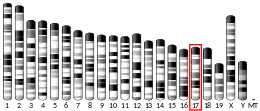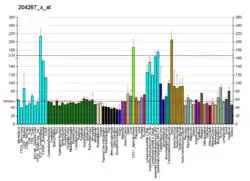| PKMYT1 | |||||||||||||||||||||||||||||||||||||||||||||||||||
|---|---|---|---|---|---|---|---|---|---|---|---|---|---|---|---|---|---|---|---|---|---|---|---|---|---|---|---|---|---|---|---|---|---|---|---|---|---|---|---|---|---|---|---|---|---|---|---|---|---|---|---|
| |||||||||||||||||||||||||||||||||||||||||||||||||||
| Identifiers | |||||||||||||||||||||||||||||||||||||||||||||||||||
| Aliases | PKMYT1, MYT1, PPP1R126, protein kinase, membrane associated tyrosine/threonine 1 | ||||||||||||||||||||||||||||||||||||||||||||||||||
| External IDs | OMIM: 602474 MGI: 2137630 HomoloGene: 31227 GeneCards: PKMYT1 | ||||||||||||||||||||||||||||||||||||||||||||||||||
| |||||||||||||||||||||||||||||||||||||||||||||||||||
| |||||||||||||||||||||||||||||||||||||||||||||||||||
| |||||||||||||||||||||||||||||||||||||||||||||||||||
| |||||||||||||||||||||||||||||||||||||||||||||||||||
| |||||||||||||||||||||||||||||||||||||||||||||||||||
| Wikidata | |||||||||||||||||||||||||||||||||||||||||||||||||||
| |||||||||||||||||||||||||||||||||||||||||||||||||||
Membrane-associated tyrosine- and threonine-specific cdc2-inhibitory kinase also known as Myt1 kinase is an enzyme that in humans is encoded by the PKMYT1 gene.[5][6][7]
Myt 1 is an enzyme in the Wee1 family and found in vertebrates. The Wee 1 family includes a variety of enzymes that all work to inhibit Cdk activity in a variety of different organisms. Myt 1 is important in regulating the cell cycle through inactivating Cdks through the phosphorylation of both Tyr 15 and Thr 14
Wee 1 family
There are other enzymes that play roles in the inactivation of Cdks in the Wee 1 family that work in a variety of different organisms. Some examples of Wee 1 family enzymes working in different species are as follows:
- S. Cerevisiae: Swe 1
- S. Pombe: Wee 1 and Mik 1
- D. Melanogaster: Dwee 1 and Dmyt 1
- Vertebrates: Wee 1 (phosphorylates only Tyr 15) and Myt 1 (phosphorylates both Tyr 15 and Thr 14)[8]
Wee 1 is present in all eukaryotes under different names and is responsible for phosphorylating Tyr 15 in each of those organisms.
In fission yeast where Wee 1 is the primary inhibitor of Cdk1, mutations in the Wee 1 gene cause premature entry into mitosis. On the other hand, the overproduction of Wee 1 blocks entry into mitosis.[8]
Tyrosine phosphorylation
Myt 1 plays an important role in inhibiting Cdk activity through phosphorylating Tyr 15 and Thr 14. Tyr 15 is highly conserved and is found in all major Cdks, however has different names in different organisms. Animal cells have an additional Thr 14 site that aids in further Cdk inactivation.[8]
Tyr 15 and Thr 14 are located on Cdks at their ATP binding site. It is thought that the phosphorylation of Tyr 15 and Thr 14 interferes with the orientation of ATP phosphates which inhibits Cdk functioning. The phosphorylation of these sites is particularly important during the beginning of mitosis as they are involved in the activation of M-Cdks. They are also believed to be involved in the timing of activation of S-phase Cdks and the entry into G1/S phase.[9]
With Myt 1 inactivating Cdks by phosphorylating both Tyr 15 and Thr 14, there needs to be a method of dephosphorylating the sites so that the Cdk can become active once again. This dephosphorylation of inhibitory sites is done by the Cdc25 family. In vertebrates, the Cdc25 enzymes are Cdc25A which controls the checkpoints of G1/S and G2/M as well as Cdc25B and Cdc25C which both control the G2/M checkpoint.[9]
Mitosis
Myt 1 and Wee 1 kinases work together to inhibit Cdk 1 before mitosis. Myt 1 and Wee 1 concentrations are high throughout most of the cell cycle to ensure the inactivation of Cdk 1. During mitosis, concentrations of Myt 1 and Wee 1 decrease substantially which allows for the dephosphorylation activity of phosphatases in the Cdc 25 family and the subsequent activation of Cdk 1.[9]
Subcellular distribution
Myt 1 is located in the membranes of the Golgi apparatus and the Endoplasmic reticulum. Since almost all cyclin B1-Cdk 1 complexes are found in the cytoplasm, Myt 1 may be the most important inhibitory kinase for Cdk 1. Since Wee 1 is mostly located in the nucleus, it is believed that Wee 1 maintains the inhibition of the small amount of Cdk 1 that is found in the nucleus[10] while Myt 1 does the rest of the inhibition. Various studies on the deletion of the Wee 1 gene in Drosophila show that an absent Wee 1 is not lethal. This suggests that the inhibition of Cdk 1 caused by Myt 1 is sufficient for mitosis. Further evidence that Myt 1 is the primary inhibitor of Cdk 1 is that Wee 1 is not found in Xenopus oocytes, leaving Myt 1 to be the sole inhibitor of Cdk 1.[9]
Regulation
The regulation of Myt 1, Wee 1, and Cdc25 lies in a positive feedback loop with Cdk 1. To regulate these three proteins, Cdk 1 hyperphosphorylates the N-terminal regulatory regions.[11] This hyperphosphorylation activates Cdc25 and inhibits Myt 1 and Wee 1. The activation of Cdc25 causes an increase in its levels and the inhibition of Myt 1 and Wee 1 causes a decrease in their levels. This positive feedback led by Cdk 1 creates a bistable system where the cell has both a state of stable inactivity of Cdk 1 and a state of stable Cdk 1 activity. This regulatory system creates a switch where Cdk 1 can be turned on and off quickly and ensures that the process will still operate even if some part fails.
Protein kinases AKT1/PKB and PLK (Polo-like kinase) have also been shown to phosphorylate and regulate the activity of Myt 1.[12] Alternatively spliced transcript variants encoding distinct isoforms have been reported.[7]
References
- 1 2 3 GRCh38: Ensembl release 89: ENSG00000127564 - Ensembl, May 2017
- 1 2 3 GRCm38: Ensembl release 89: ENSMUSG00000023908 - Ensembl, May 2017
- ↑ "Human PubMed Reference:". National Center for Biotechnology Information, U.S. National Library of Medicine.
- ↑ "Mouse PubMed Reference:". National Center for Biotechnology Information, U.S. National Library of Medicine.
- ↑ Liu F, Stanton JJ, Wu Z, Piwnica-Worms H (February 1997). "The human Myt1 kinase preferentially phosphorylates Cdc2 on threonine 14 and localizes to the endoplasmic reticulum and Golgi complex". Molecular and Cellular Biology. 17 (2): 571–83. doi:10.1128/mcb.17.2.571. PMC 231782. PMID 9001210.
- ↑ Passer BJ, Nancy-Portebois V, Amzallag N, Prieur S, Cans C, Roborel de Climens A, et al. (March 2003). "The p53-inducible TSAP6 gene product regulates apoptosis and the cell cycle and interacts with Nix and the Myt1 kinase". Proceedings of the National Academy of Sciences of the United States of America. 100 (5): 2284–9. Bibcode:2003PNAS..100.2284P. doi:10.1073/pnas.0530298100. PMC 151332. PMID 12606722.
- 1 2 "Entrez Gene: PKMYT1 protein kinase, membrane associated tyrosine/threonine 1".
- 1 2 3 Morgan DO (2007). The Cell Cycle: Principles of Control. New Science Press. p. 35. ISBN 978-0-87893-508-6.
- 1 2 3 4 Morgan DO (2007). The Cell Cycle: Principles of Control. New Science Press. pp. 96–98. ISBN 978-0-87893-508-6.
- ↑ Morgan DO (2007). The Cell Cycle: Principles of Control. New Science Press. p. 101. ISBN 978-0-87893-508-6.
- ↑ Trunnell N (2009). Multisite phosphorylation generates ultrasensitivity in the regulation of Cdc25C by Cdk1 (Ph.D. thesis). Stanford University.
- ↑ Morgan DO (2007). The Cell Cycle: Principles of Control. New Science Press. p. 193. ISBN 978-0-87893-508-6.
Further reading
- Booher RN, Holman PS, Fattaey A (August 1997). "Human Myt1 is a cell cycle-regulated kinase that inhibits Cdc2 but not Cdk2 activity". The Journal of Biological Chemistry. 272 (35): 22300–6. doi:10.1074/jbc.272.35.22300. PMID 9268380.
- Shen M, Stukenberg PT, Kirschner MW, Lu KP (March 1998). "The essential mitotic peptidyl-prolyl isomerase Pin1 binds and regulates mitosis-specific phosphoproteins". Genes & Development. 12 (5): 706–20. doi:10.1101/gad.12.5.706. PMC 316589. PMID 9499405.
- Liu F, Rothblum-Oviatt C, Ryan CE, Piwnica-Worms H (July 1999). "Overproduction of human Myt1 kinase induces a G2 cell cycle delay by interfering with the intracellular trafficking of Cdc2-cyclin B1 complexes". Molecular and Cellular Biology. 19 (7): 5113–23. doi:10.1128/MCB.19.7.5113. PMC 84354. PMID 10373560.
- Wells NJ, Watanabe N, Tokusumi T, Jiang W, Verdecia MA, Hunter T (October 1999). "The C-terminal domain of the Cdc2 inhibitory kinase Myt1 interacts with Cdc2 complexes and is required for inhibition of G(2)/M progression". Journal of Cell Science. 112 ( Pt 19) (19): 3361–71. doi:10.1242/jcs.112.19.3361. PMID 10504341.
- Pathan N, Aime-Sempe C, Kitada S, Haldar S, Reed JC (2001). "Microtubule-targeting drugs induce Bcl-2 phosphorylation and association with Pin1". Neoplasia. 3 (1): 70–9. doi:10.1038/sj.neo.7900131. PMC 1505024. PMID 11326318.
- Okumura E, Fukuhara T, Yoshida H, Hanada Si S, Kozutsumi R, Mori M, et al. (February 2002). "Akt inhibits Myt1 in the signalling pathway that leads to meiotic G2/M-phase transition". Nature Cell Biology. 4 (2): 111–6. doi:10.1038/ncb741. PMID 11802161. S2CID 22691979.
- Nakajima H, Toyoshima-Morimoto F, Taniguchi E, Nishida E (July 2003). "Identification of a consensus motif for Plk (Polo-like kinase) phosphorylation reveals Myt1 as a Plk1 substrate". The Journal of Biological Chemistry. 278 (28): 25277–80. doi:10.1074/jbc.C300126200. PMID 12738781.
- Dai X, Yamasaki K, Yang L, Sayama K, Shirakata Y, Tokumara S, et al. (June 2004). "Keratinocyte G2/M growth arrest by 1,25-dihydroxyvitamin D3 is caused by Cdc2 phosphorylation through Wee1 and Myt1 regulation". The Journal of Investigative Dermatology. 122 (6): 1356–64. doi:10.1111/j.0022-202X.2004.22522.x. PMID 15175024.
- Bryan BA, Dyson OF, Akula SM (March 2006). "Identifying cellular genes crucial for the reactivation of Kaposi's sarcoma-associated herpesvirus latency". The Journal of General Virology. 87 (Pt 3): 519–29. doi:10.1099/vir.0.81603-0. PMID 16476973.
- Nousiainen M, Silljé HH, Sauer G, Nigg EA, Körner R (April 2006). "Phosphoproteome analysis of the human mitotic spindle". Proceedings of the National Academy of Sciences of the United States of America. 103 (14): 5391–6. Bibcode:2006PNAS..103.5391N. doi:10.1073/pnas.0507066103. PMC 1459365. PMID 16565220.
- Wissing J, Jänsch L, Nimtz M, Dieterich G, Hornberger R, Kéri G, et al. (March 2007). "Proteomics analysis of protein kinases by target class-selective prefractionation and tandem mass spectrometry". Molecular & Cellular Proteomics. 6 (3): 537–47. doi:10.1074/mcp.T600062-MCP200. hdl:10033/19756. PMID 17192257.




